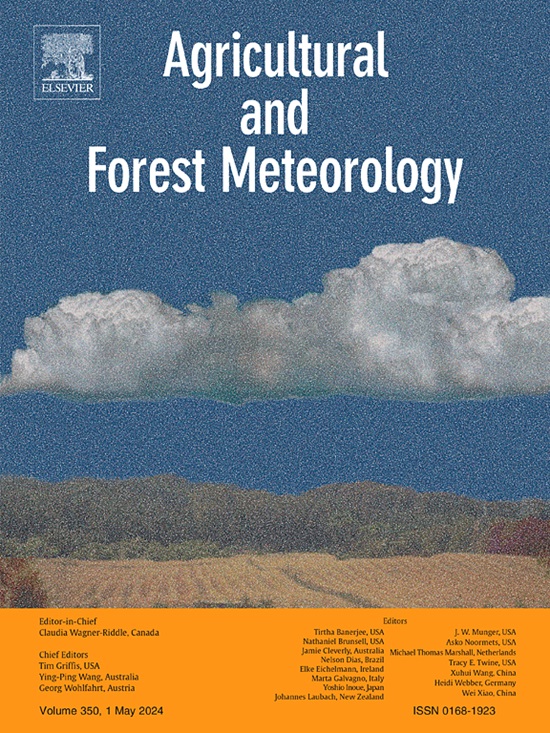Effects of fire intensity on carbon dioxide exchange in an arctic dry heath tundra
IF 5.6
1区 农林科学
Q1 AGRONOMY
引用次数: 0
Abstract
The frequency and intensity of wildfires in the Arctic has been increasing due to climate change. However, little is known about the effects of fire intensity on carbon dioxide (CO2) exchange in arctic tundra ecosystems. To investigate this, we conducted an experimental fire with different burn intensities (low intensity, high intensity, and unburned control) and measured surface daytime CO2 fluxes over four growing seasons in a dry heath tundra in West Greenland. We found that post-fire soil temperatures and moisture increased with increasing fire intensity, by up to 2.2 °C and 18 vol%, respectively. Fire had no effects on soil microbial biomass independent of intensity. The high-intensity fire increased soil nitrate concentrations only immediately after the fire. The ecosystem shifted from a net CO2 sink to a net CO2 source immediately after the fire, due to the reduced gross ecosystem production. One year after the fire, the low-intensity burned plots became a net CO2 sink, while the high-intensity burned plots remained a net CO2 source throughout the study period. This suggests that the time needed for the ecosystem to become a net CO2 sink increases with fire intensity. Fire intensity had no effect on soil respiration, but the high-intensity fire significantly reduced ecosystem respiration (ER) rates one and three years after the fire. This suggests that decreased ER was mainly driven by the reduced aboveground plant respiration. Over four growing seasons after the high-intensity fire, cumulated post-fire C losses exceeded the C losses during the fire. Thus, it is essential to consider the long-term C losses following fire to improve understanding of wildfire impacts on arctic tundra C dynamics. Overall, this study highlights that high-intensity fires prolong the duration of burned areas as a net CO2 source, leading to increased post-fire CO2 emissions, when compared to low-intensity fires.
火灾强度对北极干燥荒原冻土带二氧化碳交换的影响
由于气候变化,北极地区野火的发生频率和强度不断增加。然而,人们对火灾强度对北极苔原生态系统二氧化碳(CO2)交换的影响知之甚少。为了研究这个问题,我们在西格陵兰的干燥石楠苔原上进行了不同燃烧强度(低强度、高强度和未燃烧对照)的实验性火灾,并测量了四个生长季节的地表白天二氧化碳通量。我们发现,火灾后土壤温度和湿度随着火灾强度的增加而上升,上升幅度分别高达 2.2 °C 和 18 vol%。火灾对土壤微生物生物量没有影响,与强度无关。高强度火灾仅在火灾后立即增加了土壤硝酸盐浓度。火灾发生后,由于生态系统总产量减少,生态系统立即从二氧化碳净汇转变为二氧化碳净源。火灾一年后,低强度燃烧的地块变成了二氧化碳净吸收汇,而高强度燃烧的地块在整个研究期间仍然是二氧化碳净来源。这表明,生态系统成为二氧化碳净吸收汇所需的时间随火灾强度的增加而增加。火灾强度对土壤呼吸作用没有影响,但高强度火灾显著降低了火灾后一年和三年的生态系统呼吸率(ER)。这表明ER的降低主要是由地上植物呼吸作用的减少引起的。在高强度火灾后的四个生长季中,火灾后累积的碳损失超过了火灾期间的碳损失。因此,必须考虑火灾后的长期碳损失,才能更好地理解野火对北极苔原碳动态的影响。总之,这项研究强调,与低强度火灾相比,高强度火灾延长了作为二氧化碳净来源的燃烧区域的持续时间,导致火后二氧化碳排放量增加。
本文章由计算机程序翻译,如有差异,请以英文原文为准。
求助全文
约1分钟内获得全文
求助全文
来源期刊
CiteScore
10.30
自引率
9.70%
发文量
415
审稿时长
69 days
期刊介绍:
Agricultural and Forest Meteorology is an international journal for the publication of original articles and reviews on the inter-relationship between meteorology, agriculture, forestry, and natural ecosystems. Emphasis is on basic and applied scientific research relevant to practical problems in the field of plant and soil sciences, ecology and biogeochemistry as affected by weather as well as climate variability and change. Theoretical models should be tested against experimental data. Articles must appeal to an international audience. Special issues devoted to single topics are also published.
Typical topics include canopy micrometeorology (e.g. canopy radiation transfer, turbulence near the ground, evapotranspiration, energy balance, fluxes of trace gases), micrometeorological instrumentation (e.g., sensors for trace gases, flux measurement instruments, radiation measurement techniques), aerobiology (e.g. the dispersion of pollen, spores, insects and pesticides), biometeorology (e.g. the effect of weather and climate on plant distribution, crop yield, water-use efficiency, and plant phenology), forest-fire/weather interactions, and feedbacks from vegetation to weather and the climate system.

 求助内容:
求助内容: 应助结果提醒方式:
应助结果提醒方式:


